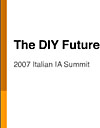The DIY Future: what happens when everyone is a designer?
In his seemingly very interesting presentation, he talks about integrated experiences, the need for permeability, and conflict as the missing ingredient in design – and also puts the work of Peter Morville, Bruce Sterling and Jesse James Garrett in a new context.
He just posted the abstract and the slides online. I hope audio will soon be available as well.
Broad cultural, technological, and economic shifts are rapidly erasing the distinctions between those who create and those who use, consume, or participate. This is true in digital experiences and information environments of all types, as well as in the physical and conceptual realms. In all of these contexts, substantial expertise, costly tools, specialized materials, and large-scale channels for distribution are no longer required to execute design.
The erosion of traditional barriers to creation marks the onset of the DIY Future, when everyone is a potential designer (or architect, or engineer, or author) of integrated experiences – the hybrid constructs that combine products, services, concepts, networks, and information in support of evolving functional and emotional pursuits.
The cultural and technological shifts that comprise the oncoming DIY Future promise substantial changes to the environments and audiences that design professionals create for, as well as the role of designers, and the ways that professionals and amateurs alike will design. One inevitable aspect consequence will be greater complexity for all involved in the design of integrated experiences. The potential rise of new economic and production models is another.
The time is right to begin exploring aspects of the DIY Future, especially its profound implications for information architecture and user experience design. Using the designer’s powerful fusion of analytical perspective and creative vision, we can balance speculative futurism with an understanding of concrete problems – such as growing ethical challenges and how to resolve them – from the present day.
View slideshow (click on “full”) | Download slideshow




